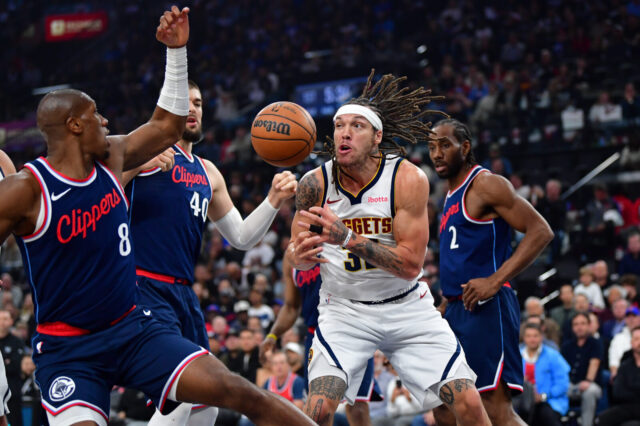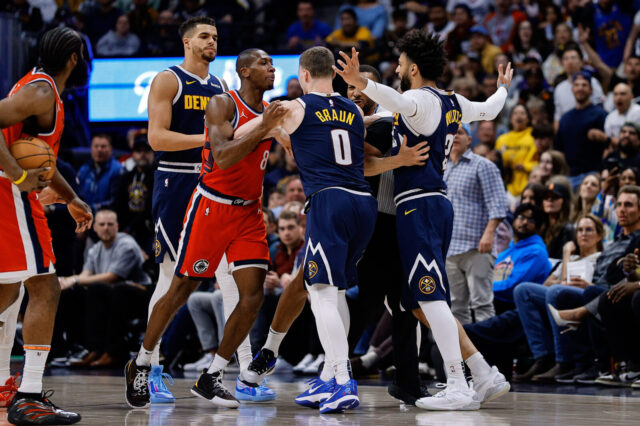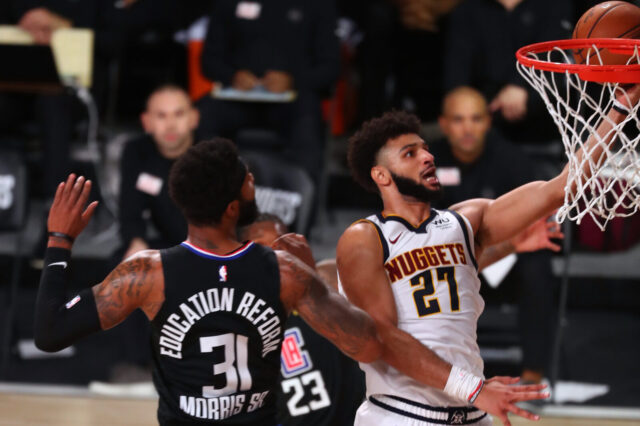Jamal Murray Player Evaluation
Overview
Jamal Murray had a great sophomore season for the Denver Nuggets. After showing flashes of what he could be during his rookie year, Murray took off in a larger role this year. Averaging 16.7 points per game as the starting point guard, he became one of the leaders on a 46-win team in just his 20-year-old season.
This content is no longer available.
16.7 points on 50.2% shooting, 37.8% from behind the arc, and 90.5% from the free throw line is rare for a 20-year-old. Actually, it’s never been done in the history of the NBA by someone his age or younger. Open the search up to all age groups, and the youngest player to accomplish it (other than Murray) is a three-way tie between Mark Price, Kevin Durant, and Kyrie Irving.
This content is no longer available.
Now, most of the players here are All-Stars, Hall of Fame caliber players, etc., but the cutoff is artificial. There’s no reward for hitting these cutoffs, but it shows what Murray may be capable of if he develops to become his best self. For now, Murray is an excellent second year player, battling to be the second best player in the 2016 class with Jaylen Brown and Brandon Ingram (behind Ben Simmons of course). That’s a great place to be for him, especially because he still has a lot of room for growth.
Key stat – Shooting efficiency by number of dribbles
This content is no longer available.
As Murray improves as a scorer, the best thing to do is to improve as a scorer with the ball in his hands. He’s nearly elite off the catch-and-shoot already. Of the 122 players with 40 games played and three or more catch-and-shoot attempts per game, his 60.8 eFG% ranks 17th. In terms of scoring without a dribble or with just one dribble, Murray is one of the more efficient guards in the NBA. The best way for him to get better is to simply find more opportunities to take shots.
Where he has really improved is his efficiency inside the arc after an increasing number of dribbles. He’s in the green (above average or better) in all areas except the 3-6 range, but he improved from that range as well. Murray is taking steps with the ball in his hands, and it is so important for Denver’s ceiling if he can be an efficient option at the end of shot clocks with a simple pick and roll with Jokic.
During his rookie year, he was excellent in isolation situations, so he was bound for regression; however, he still shows flashes of doing the things elite NBA guards do on a consistent basis.
If Murray is to truly blossom, improving as a three-point shooter in those end of clock situations will go a long way, which is usually where those 3-6 and 7+ dribble numbers come from. In the very late shot clock situations (0-4 seconds left) Murray shot 17/59 (28.8%) from behind the arc. It’s not an egregiously bad number, but very few players take that many threes at the end of the clock. Being able to go quicker and command what the defense does will surely help him stay more efficient, as generally, players become less efficient later in the clock.
Best moment – Clutch time vs Milwaukee to save Denver’s season
How can it not be this game? The seconds on Denver’s season were ticking down, and Murray just kept finding a way. As a facilitator, defender when he had to be, and as a scorer, Murray brought it when it counted, going for 27 points and 7 assists, including three clutch free throws to send the game to overtime. His ability to create offense at all three levels, find Jokic in the pick and roll, and just be a bucket getter are paramount to Denver’s future success. May I remind you that the guy just turned 21 late this season?
Areas of strength
Off-ball scoring
As I touched on earlier, Murray’s scoring profile is more similar to an elite shooting guard than a point guard. Most of his efficiency comes from a standstill or on quick decision plays, rather than being a traditional facilitator. Because of the presence of Nikola Jokic, the Nuggets don’t need him to be something he’s not. They need him to do what he does best, and that’s be aggressive as a scorer while reacting as a passer. Eventually, his assist numbers will rise organically because he’s more comfortable with the ball in his hands. Right now though, he’s a strong scorer in the off-ball categories and should continue to excel there.
Improved decision making
While Murray wasn’t asked to be the traditional facilitator, as a point guard, his responsibility on certain plays asked him to handle the ball more frequently and create for others. As the season progressed, he became more confident as a passer, averaging 4.4 assists after the All-Star break as opposed to the 2.9 before it. His assists increased during this time, but his turnovers stayed roughly the same. Finding players in certain sets will be important for Murray’s development with the ball in his hands. If he can make the simple plays as a passer, it will help his game as a scorer.
Clutch Gene
As mentioned earlier, Murray is excellent in most late game situations. His free throw percentage of 90.5% can attest to that. In clutch situations, that number rose to 96.3%, as he went 26/27! He was Denver’s most efficient volume scorer in the clutch, was second on the team in assists behind Jokic, and had less turnovers than either Jokic or Will Barton. He wasn’t perfect, but in my opinion, he was the best sophomore in the clutch this year, better than Simmons, Ingram, Brown, or Kris Dunn. As Denver continues to develop, they will need Murray and his clutch time heroics, but given his current trajectory, they should have high confidence in his abilities to improve.
Areas to improve
Defense
As with most members of the Denver Nuggets, Jamal Murray struggled defensively this year. While most 20-year-olds struggle, Murray’s issues are more prominent given the offensive load he must also carry in future years. With Murray on the floor, the Nuggets posted a 109.7 defensive rating, compared to the 107.3 defensive rating with him off the floor. Each of Denver’s other starters had the opposite trend. Nikola Jokic, the player most associated with Denver’s defensive issues, had the defense improve by nearly five points per 100 possessions when Murray sat on the bench.
- Murray’s defensive rating with Nikola Jokic on the floor: 111.4 points per 100 possessions.
- Murray’s defensive rating with Nikola Jokic on the bench: 115.6 points per 100 possessions.
- Jokic’s defensive rating with Jamal Murray on the bench: 106.6 points per 100 possessions.
Those are damning numbers for Murray, and he will have to improve on that side of the floor if the Nuggets ever desire to be a championship contender.
Hitting Nikola Jokic on the roll to the rim
During his second season, Nikola Jokic was excellent as a scorer in the pick and roll, either getting all the way to the rim or using his touch to hit the short floater in the 5-10 foot range on the floor. He averaged 1.15 points per possession on 2.3 possessions per game, good for the 74th percentile.
This season, he has dropped to 1.05 points per possession on 3.4 possessions, good for the 44th percentile. Part of this is because he’s taking slightly less free throws, but the primary factor is because he’s popping to the top of the key more frequently as a jump shooter to space the floor. This is a good way to stretch out the defense, but mixing in some more rolls to the rim is important. The pass to the top of the key is a far easier pass to make as a guard, and Murray has done it well.
Where he will take his game (and Denver’s offense) back to elite level his his pocket pass to a rolling Jokic. Nikola Jokic in a 4-on-3 situation rolling to the rim against a scrambling defense is the most ideal situation for Denver in the half court. With spot up shooters, an excellent decision maker, and potentially a short corner guy to receive easy dump-offs, Murray must be able to trigger that first pass.
Expectations for next season
It’s hard not to expect the moon from Murray. Very few second-year guards average 16 points a night on a playoff caliber squad. Even fewer do it as efficiently and with as much poise as Murray. The guards 21 years old or younger in their second seasons to average greater than 15 points a night are as follows:
This content is no longer available.
Sorted by true shooting percentage, Murray comes as the best of them. which frankly is amazing. Between recent young studs in Kyrie Irving, Bradley Beal, and Devin Booker, as well as previous superstars in Kobe Bryant, Chris Paul, and Derrick Rose, Murray matches up well here.
His next step is improving in volume. Of the other 17 players listed, the average field goal attempts per game increased from 14.9 to 16.1 among the above players, and I would expect an increase in shot attempts out of Murray as well. Half of the above players averaged 20 points per game or more in their third season, and I think it’s possible that Murray joins them.
If Murray maintains similar percentages next year on increased volume, he will be posting borderline All-Star numbers, even in the Western Conference. Only 10 guards in the West averaged 20 points per game last year, and six of them made the All-Star game. If Murray were to join them, the dynamics of this Nuggets roster would change completely.
There is always the possibility that Murray tops out as a good scorer who struggles in the pick and roll, but I wouldn’t put my money on that. Given Murray’s natural talents and extreme work ethic, I would put my money on him taking the necessary steps to become a better player. I would also bet on him learning to control the tempo of the game. This is something Stephen Curry, Damian Lillard, and James Harden do extremely well, and if Murray continues to be put in these positions at a young age, he will be hard to stop next year and in future years.


